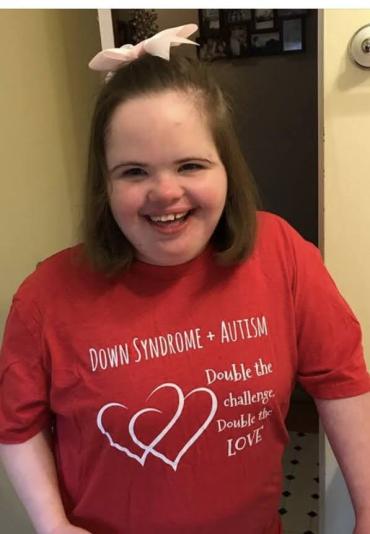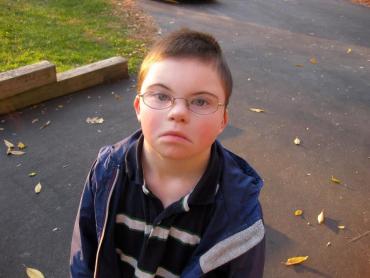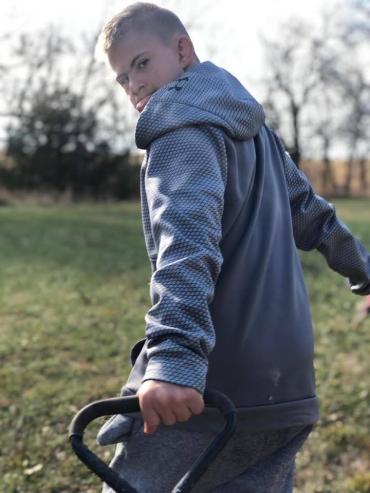Down Syndrome and Autism Spectrum Disorder (DS-ASD)
Can a person with Down syndrome also have autism?
Yes! In fact, about 16-18% of people with Down syndrome also have autism spectrum disorder (ASD) (Richards et al., 2015). However, it is important to know that:
- Like autistic people, people with Down syndrome have a range of skills and vary in achieving developmental milestones
- The common characteristics of autism may appear differently in people who also have Down syndrome
- People with Down syndrome without autism may have some similar behaviors to people with autism
- Strategies and interventions that help autistic people can also often help those with Down syndrome
What are the symptoms of DS-ASD?
When autism occurs in someone with Down syndrome, the characteristics of autism (social and behavioral challenges, communication difficulties and restricted interests) may be observed in addition to the symptoms of Down syndrome (intellectual disability, speech and language delays).
Below are some common traits you may see in a person with DS-ASD.
Note: Having one or even several of these symptoms does not necessarily mean a person with Down syndrome has autism. If there are many symptoms, further evaluation may be needed.
Challenges with social communication and social interaction
- Does not seem to notice people or try to get their attention
- Makes less eye contact or avoids eye contact
- Does not respond to someone calling their name or attempting to interact with them
- Does not try to imitate others (e.g., using hand motions for songs)
- Has difficulty showing wants and needs without words (e.g., no pointing, gesturing or motioning)
- Experiences loss of speech, language, communication, play or social skills, either suddenly or over time
- Less likely to communicate verbally
Note: People with Down syndrome without autism may show some language delays but effectively use gestures, have a range of facial expressions and play well with others. People with DS-ASD may have more significant language delays (especially in the social use of language) and limited use of gestures, facial expressions and play skills.
Restricted or repetitive behaviors/interests
- Plays with toys or objects in a repetitive way, not as intended (e.g., spinning/twirling objects over and over, lining up objects in patterns or sequences)
- Makes repetitive movements that can be disruptive and/or hard to redirect (e.g., flapping hands or arms, rocking, head shaking)
- Makes unusual or repetitive sounds (often in a high-pitched voice or monotone) or says phrases or sentences that have no meaning
Note: People with Down syndrome without autism may show some of these behaviors, but they are less prominent than in people with DS-ASD. These behaviors may be more challenging in autistic people without Down syndrome than in people with DS-ASD.
Sensory challenges
- Gets overwhelmed by sudden loud noises (e.g., babies crying, laughter, singing)
- Resistant to physical affection (e.g., cuddles, hugs)
- Resistant to personal grooming tasks (e.g., hair brushing, tooth brushing, haircuts, shaving, nail trimming)
- Avoids or has strong reactions to certain smells, tastes, and/or textures
Note: People with Down syndrome without autism may have some of these sensory challenges, but they are less disruptive than in people with DS-ASD. In people with autism alone, these sensory challenges may be more disruptive and/or intense than in people with DS-ASD. Sensory sensitivities can also cause behavioral challenges.
Behavioral challenges
- Has frequent tantrums, “melt-downs," or “drop and flops” (e.g., when disrupted or agitated, cries or falls to ground and refuses to move)
- Runs away or escapes without warning
- Displays self-harming behaviors (e.g., banging head against the wall)
- Has extreme difficulty with even minor changes in routine
Note: People with Down syndrome without autism may show some of these behaviors, but they are less disruptive than in people with DS-ASD. In people with autism alone, these behaviors may be more challenging than in people with DS-ASD.
How does DS-ASD present differently than autism or Down syndrome alone?
Compared to people with Down syndrome without autism, it is more common for people with DS-ASD to have:
- Difficulties with communication, social engagement, sensory sensitivities and behavioral challenges
- Restricted or repetitive behaviors
- Significant cognitive challenges, resulting in slower processing speeds
Compared to autistic people, it is more common for people with DS-ASD to:
- Show more social interest in peers
- Have more significant cognitive challenges
- Have slower processing speeds that may be misinterpreted as stubbornness
- Display less severe repetitive behaviors than those with autism alone
What medical conditions are commonly linked to Down syndrome (including DS-ASD)?
The following medical conditions are more common in Down syndrome:
- Vision difficulties
- Hearing problems
- Thyroid disorder
- Obstructive sleep apnea and other sleep difficulties
- Celiac disease
- Seizure disorders
- Congenital heart disease
- Anatomical gastrointestinal (GI) tract anomalies
- Trouble swallowing and/or chewing
- Very low muscle tone, or hypotonia
- Very delayed motor skills
- Breathing conditions or illnesses (i.e., pneumonia)
Note: Many of these medical conditions, as well as other behavioral/mental health conditions and chronic pain, can affect behavior and development and lead to behaviors that may look like autism.
What should I do if I think my loved one has DS-ASD?
If you think your loved one with Down syndrome also has autism, the first step is to discuss the concern with a pediatrician or primary care physician who can refer them for a formal evaluation. A formal autism diagnosis can be made by a professional specializing in autism evaluation, such as a developmental pediatrician, neurologist, psychologist and/or psychiatrist.
Your doctor can also order tests to screen for medical issues other than autism which might affect behavior and learning. At a minimum, vision and hearing screens and thyroid function tests should be performed.
Why pursue an evaluation or formal diagnosis?
Receiving a formal evaluation and/or diagnosis can lead to a better understanding of your child’s behavior and give you access to critical autism resources, interventions and support that have been shown to improve outcomes.
A formal diagnosis could:
- A formal diagnosis can legitimize a family’s concerns about their loved one’s development and open the door to greater community and support.
- Help parents and family members better understand, support and guide their loved one
- Explain why your loved one is developing or acting differently than their peers with Down syndrome
- Provide access to strategies, interventions and therapies aimed at improving interactions and decreasing behavioral challenges
- Help access needed educational and community services and social supports that are tailored to a person with DS-ASD
- Help health and educational professionals better understand additional factors they need to consider during evaluation, treatment and in creation of educational goals and strategies that support the individual’s learning needs
Where can I learn more?
Parents
- National List of Down Syndrome Clinics
- Down Syndrome- Autism Connection (family support, newsletters, resource list, welcome kit, and more)
- Charlie's Clinic
- The Dual Diagnosis of Autism and Down Syndrome - YouTube
- The Arc (National) Advocacy Centers
- Autism in Children with Down Syndrome | Interactive Autism Network (iancommunity.org)
- Recommendations to Caregivers Handout
- LuMind IDSC Foundation
Helpful Books:
- When Down Syndrome and Autism Intersect, A Guide for Parents and Professionals, 2013 (Froehlke and Zaborek [Sattel])
- When Down Syndrome and Autism Intersect: A Guide to DS-ASD for Parents and Professionals, 2nd Edition, 2024 (Froehlke and Sattel)
Professionals
- Recommendations to Providers Handout
- Down Syndrome Medical Interest Group USA (DSMIG-USA)
- Association of University Centers on Disabilities
- AAP Guidelines
- National List of Down Syndrome Clinics
- Global Down Syndrome Foundation
Publications:
For Behavioral Therapists
- Applied behavior analytic interventions for children with autism: A description and review of treatment research (Granpeeshe et al, 2009)
- Addressing challenging behaviour in children with Down syndrome: the use of applied behaviour analysis for assessment and intervention (Feely & Jones, 2006)
For Speech and Occupational Therapists
- Down Syndrome and Autism Spectrum Disorder Dual Diagnosis: Important Considerations for Speech-Language Pathologists (Versaci et al, 2021)
- Sensory Integration: Observations of Children with Down Syndrome and Autistic Spectrum Disorders (Lashno, 1999)
For Medical Providers
- Evaluation, Diagnosis, and Treatment of Gastrointestinal Disorders in Individuals With ASDs: A Consensus Report (Buie et al, 2010)
- DS-Connect Down Syndrome Registry
- George Capone, M.D. Dual Diagnosis of DS-ASD
This page was created in collaboration with Down Syndrome Medical Interest Group USA (DSMIG-USA).







